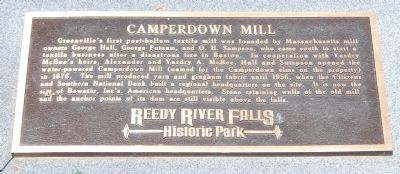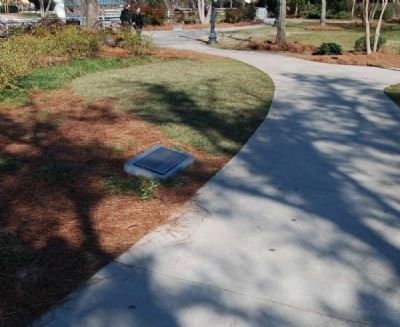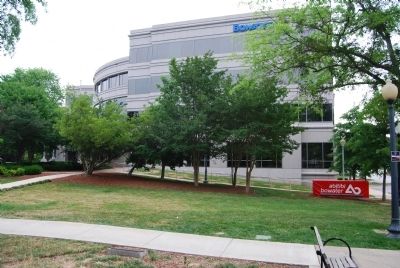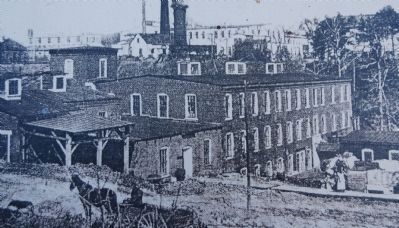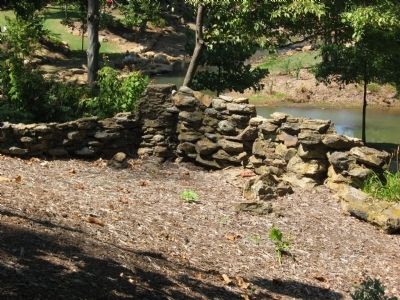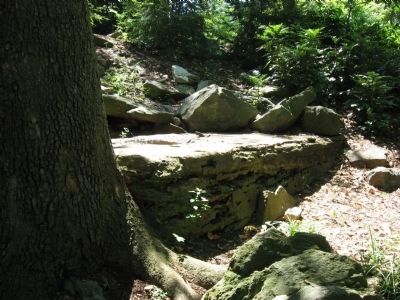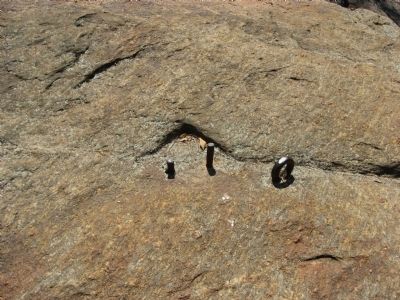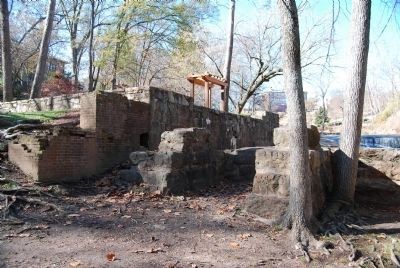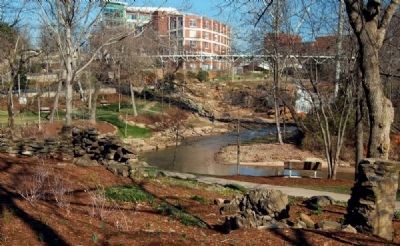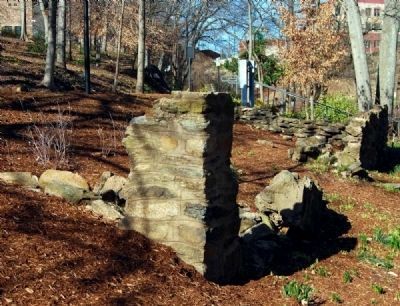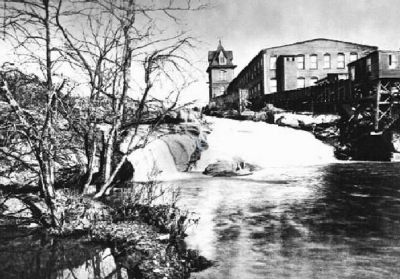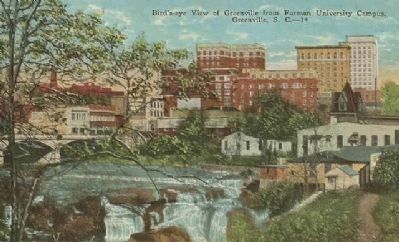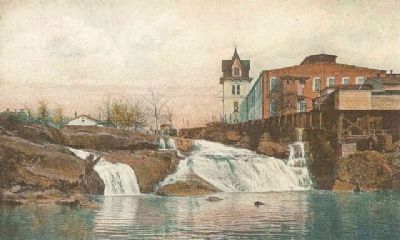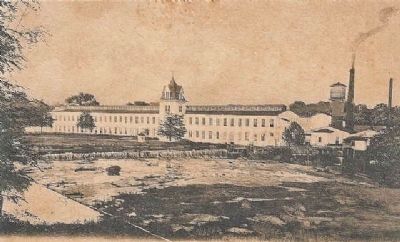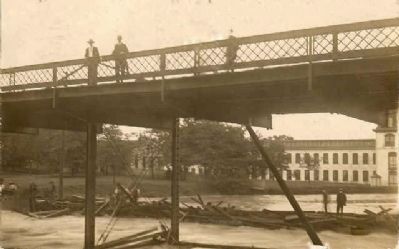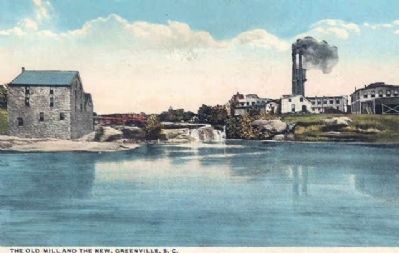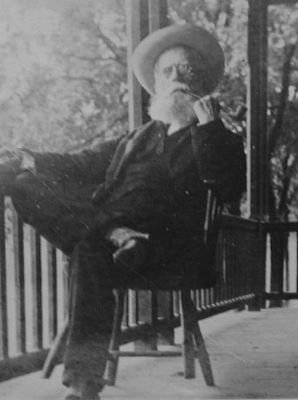Greenville in Greenville County, South Carolina — The American South (South Atlantic)
Camperdown Mill
Reedy River Historic Park
Greenville's first post-bellum textile mill was founded by Massachusetts mill owners George Hall, George Putnam, and O.H. Sampson, who came south to start a textile business after a disasterous fire in Boston. In cooperation with Vardry McBee's heirs, Alexander and Vardry A. McBee, Hall and Sampson opened the water-powered Camperdown Mill (named for the Camperdown elms on the property) in 1876. The mill produced yarn and gingham fabric until 1956, when the Citizens and Southern National Bank built a regional headquarters on the site. It is now the site of Bowater, Inc's American headquarters. Stone retaining walls of the old mill and the anchor points of its dam are still visible above the falls.
Topics. This historical marker is listed in these topic lists: Industry & Commerce • Notable Places. A significant historical year for this entry is 1876.
Location. 34° 50.691′ N, 82° 24.031′ W. Marker is in Greenville, South Carolina, in Greenville County. Marker can be reached from Falls Street near Camperdown Way (South Carolina Highway 124). This marker is located in Greenville's historic Falls Park, on the east end of the Liberty Bridge. Touch for map. Marker is in this post office area: Greenville SC 29601, United States of America. Touch for directions.
Other nearby markers. At least 8 other markers are within walking distance of this marker. Richard Pearis (here, next to this marker); Cradle of Greenville (here, next to this marker); The Falls and Industry 1800’s – 1960 (a few steps from this marker); The Falls Forgotten 1960 - 2002 (a few steps from this marker); Falls Reclaimed and the Liberty Bridge 2004 (a few steps from this marker); Liberty Bridge (within shouting distance of this marker); The Reedy River (within shouting distance of this marker); Paul Ellis, III Overlook (within shouting distance of this marker). Touch for a list and map of all markers in Greenville.
More about this marker. This marker is one of a series of markers in the Historic Falls Park covering bits of Greenville's history.
Also see . . . The Greenville Textile Heritage Society. Society website homepage (Submitted on January 26, 2022, by Larry Gertner of New York, New York.)
Additional commentary.
1. Camperdown Mill No. 1
Greenville County had a handful of start up textile mills prior to the Civil War, but not enough to make a significant contribution to the overall local economy. The nearby Batesville mill and a few others supplied enough raw materials for locals so that they didn't have to wait for imports from New England for their needs. After the Civil War, businessmen turned to the river to help rebuild their economy with textiles. The first mill in the city of Greenville to locate on the river was the Sampson & Hall Mill in 1874, leased from Vardry A. and Alexander McBee (sons of Vardry McBee) to Oscar Sampson, George Hall and George Putnam. These Massachusetts businessmen came to the Upstate looking for a new start in the South after their cotton commission business burned in Boston's great fire of 1872. They came to an area that was still recovering from the Civil War and had little precedence in textile production. However, because of their experience in the cotton industry, they looked to start a textile mill. The first mill built was located just below the lower falls in what is not Falls Park. A mill village housing the more than fifty employees soon grew up in the area surrounding the mill along the slopes of the hill and east toward Falls Street. Just as the earlier gristmills had dams and water sluices to shuttle the water to their water wheels, so did the first textile mills in the city. A pair of large water wheels turned a shaft that powered the machinery inside. Ruins of the water wheel housing still remain in the park as a reminder of this once thriving mill.
According to Ray Belcher, the Camperdown Mills failed in 1885 and was reorganized as Camperdown Cotton Mills under the leadership of successful Piedmont Manufacturing owner Henry Hammett. However, the mill continued to struggle and closed in 1894. Oscar Sampson bought the machinery and moved it out the next year to use it in his new textile venture called the Sampson Mill located off Buncombe Road. Downtown Greenville's first mill was resurrected in 1906 when Luther McBee began operations. He renamed the business Vardry Cotton Mills and hired seventy-five operators to produce coarse yarn products.
By 1923 the Vardry Mill closed for good and was soon used as a storage building for Furman University on the hill above. In 1943, the mill burned down and the cause of the fire was never solved by authorities. However, local historian Richard Sawyer was giving a tour of the park in recent years and told the history of the Vardry Mill with its mysterious demise. One of the men on the tour said that when he was young, he and his friends had a secret clubhouse in the old mill and were having a meeting. They forgot to blow out a candle after leaving and the mill, laden with flammable paper products, easily caught fire. Today ruins of the lower walls, wheelhouse structure and foundation remain in the park. (Source: A Guide to Historic Greenville, South Carolina by John Nolan (2008), pgs 23-24.)
— Submitted March 29, 2010, by Brian Scott of Anderson, South Carolina.
2. Camperdown Mill No. 2
The successful outlook of Sampson and Hall's first mill caused a new joint stockholding venture to build another mill in (225 by 64 feet) on the eastern bank of the upper falls. The 1874 mill across the river was renamed the Camperdown Mill No. 1 and the new mill opened in March 1876 as the Camperdown Mill No. 2. Like its gristmill predecessors, Camperdown No. 2 started out a a water-powered mill with a dam and water sluice. If you look along the cliff at the side of the waterfall today, you will see two partial pillars of brick that were once the foundations for the mill's water tower.
After six years, the Camperdown Mill's business was booming and employed several hundred operatives. Success was short-lived, however, as the mill went under in 1885 and was soon reorganized by Henry Hammett, the most successful mill owner in ate nineteenth-century Greenville. He renamed the mill the Camperdown Cotton Mills, but its resurrection lasted less than a decade. The large mill was not used for several years at the end of the nineteenth century, but resumed operation again in early 1901 to the cheers of locals who had hopes that it would fuel the economy once again. Twentieth-century products of the mill included finished gingham and plaid fabrics similar to the nearby Huguenot Mill. When the mill reopened, a total of eight mills were then in operation within a two-mile radius of the city employing thousands of men, women, and children.
Camperdown No. 2 continued to struggle prior to World War II and went bankrupt in 1930. Despite its ups and downs of success over the years, Batesville Mill President Mary Putnam Gridle said in 1929 that the "Camperdown Mill and the running to Greenville of the Seaboard Airline Railway track put the town on its feet and started it climbing to the pinnacle it has now achieved, the manufacturing centers of South Carolina." By the 1950s the mill could not keep up with cheap competition from Japanese makers. Its doors closed for the last time in 1956 and left 275 workers without jobs. The mill was finally demolished in 1959 and locals mourned when the distinctive old tower (which stubbornly took two days to tear down) no longer graced the skyline. Remnants of the mill likely endure today in other local structures as contractors, carpenters and "do-it-yourselfers" salvaged the bricks and timber for other projects. The property was bought by Citizens and Southern Bank in order to build its modern regional headquarters in the picturesque site. With a hew years the Camperdown Bridge was built over the falls and dozens of Camperdown
Mill village homes were torn down to make way for the Church Street extension project. The bank was torn down in 1991 and a newer building was erected as the home of another headquarters -- specialty paper and newspaper giant, Bowater (now AbitibiBowater.) (SourceA Guide to Historic Greenville, South Carolina by John Nolan (2008), pgs 25-26.)
— Submitted March 29, 2010, by Brian Scott of Anderson, South Carolina.
3. Facts About the Camperdown Mill Workers
• Camperdown employed 265 people in 1880.
• The four youngest workers were age nine, the oldest age 64. Seven children were age 10, six were age 11, twenty were age 12, ten were age 13, fourteen were age 14, and ten were age 15. Therefore 71 were under the age of sixteen.
• Where the workers came from. As expected, most were born in South Carolina – 208. However, workers came from several other states and countries, including, North Carolina (28), Alabama (5), Georgia (4), New York (1) Ohio (1), Rhode Island (1), Connecticut (1), Mississippi (1), Massachusetts (1), Tennessee (2) Virginia (2), England (6), Canada (1), Ireland (1), and Scotland.
• Many of the workers, particularly the young women, boarded with local families.
• Race. While the vast majority of the operatives were Caucasian, it is interesting to note that thirteen operatives were African American and three were Mulatto. At least two of these men held more technical positions. One was an engineer and the other a millwright. (Source: The First Families of Camperdown by Penelope Forrester (2009), pg 1.)
— Submitted October 24, 2010, by Brian Scott of Anderson, South Carolina.
Credits. This page was last revised on March 21, 2022. It was originally submitted on June 1, 2008, by Brian Scott of Anderson, South Carolina. This page has been viewed 2,955 times since then and 99 times this year. Last updated on August 19, 2015, by Byron Hooks of Sandy Springs, Georgia. Photos: 1. submitted on June 1, 2008, by Brian Scott of Anderson, South Carolina. 2. submitted on March 29, 2010, by Brian Scott of Anderson, South Carolina. 3. submitted on June 1, 2008, by Brian Scott of Anderson, South Carolina. 4. submitted on December 20, 2008, by Brian Scott of Anderson, South Carolina. 5, 6, 7. submitted on August 11, 2008, by Ronald Miller of Gray Court, South Carolina. 8. submitted on December 20, 2008, by Brian Scott of Anderson, South Carolina. 9, 10. submitted on March 27, 2010, by Brian Scott of Anderson, South Carolina. 11. submitted on March 28, 2009, by Brian Scott of Anderson, South Carolina. 12, 13, 14, 15, 16. submitted on October 24, 2010, by Brian Scott of Anderson, South Carolina. 17. submitted on March 31, 2010, by Brian Scott of Anderson, South Carolina. • Bill Pfingsten was the editor who published this page.
